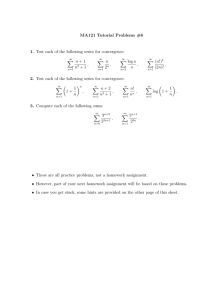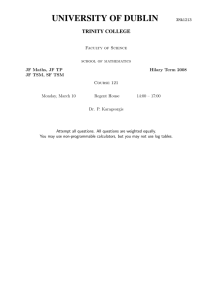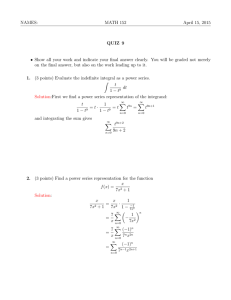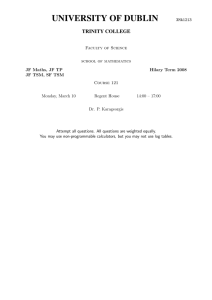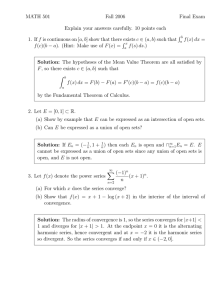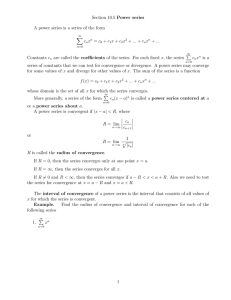221 ON THE QUASI–UNIFORM CONVERGENCE OF TRANSFINITE SEQUENCES OF FUNCTIONS
advertisement
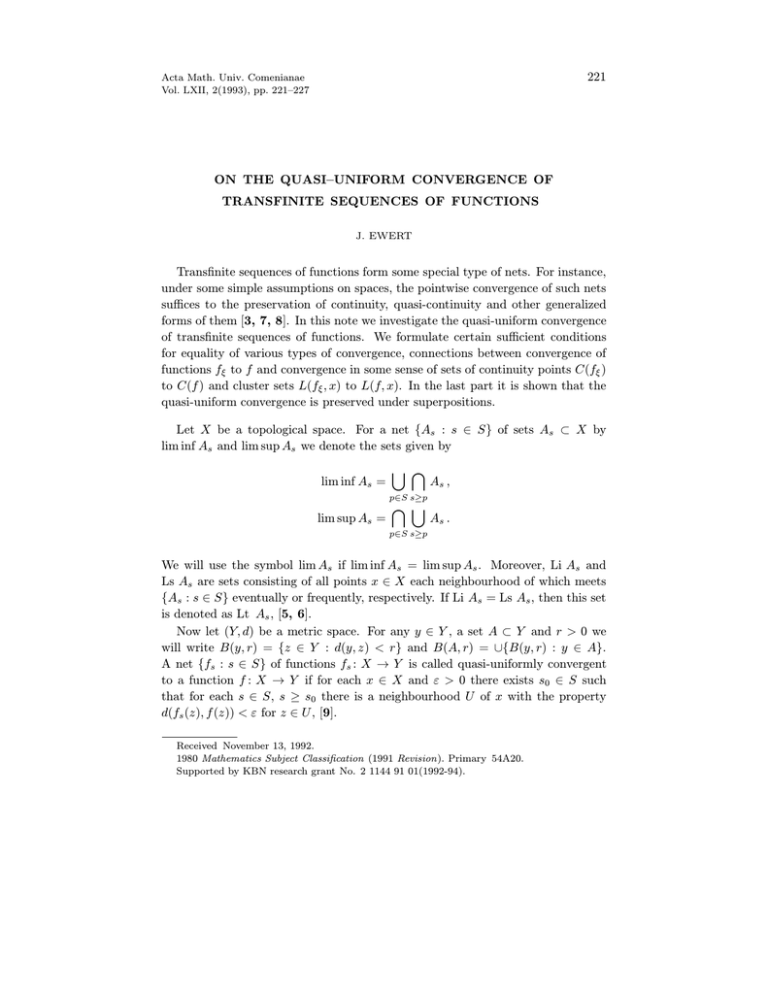
221
Acta Math. Univ. Comenianae
Vol. LXII, 2(1993), pp. 221–227
ON THE QUASI–UNIFORM CONVERGENCE OF
TRANSFINITE SEQUENCES OF FUNCTIONS
J. EWERT
Transfinite sequences of functions form some special type of nets. For instance,
under some simple assumptions on spaces, the pointwise convergence of such nets
suffices to the preservation of continuity, quasi-continuity and other generalized
forms of them [3, 7, 8]. In this note we investigate the quasi-uniform convergence
of transfinite sequences of functions. We formulate certain sufficient conditions
for equality of various types of convergence, connections between convergence of
functions fξ to f and convergence in some sense of sets of continuity points C(fξ )
to C(f ) and cluster sets L(fξ , x) to L(f, x). In the last part it is shown that the
quasi-uniform convergence is preserved under superpositions.
Let X be a topological space. For a net {As : s ∈ S} of sets As ⊂ X by
lim inf As and lim sup As we denote the sets given by
lim inf As =
[ \
As ,
p∈S s≥p
lim sup As =
\ [
As .
p∈S s≥p
We will use the symbol lim As if lim inf As = lim sup As . Moreover, Li As and
Ls As are sets consisting of all points x ∈ X each neighbourhood of which meets
{As : s ∈ S} eventually or frequently, respectively. If Li As = Ls As , then this set
is denoted as Lt As , [5, 6].
Now let (Y, d) be a metric space. For any y ∈ Y , a set A ⊂ Y and r > 0 we
will write B(y, r) = {z ∈ Y : d(y, z) < r} and B(A, r) = ∪{B(y, r) : y ∈ A}.
A net {fs : s ∈ S} of functions fs : X → Y is called quasi-uniformly convergent
to a function f : X → Y if for each x ∈ X and ε > 0 there exists s0 ∈ S such
that for each s ∈ S, s ≥ s0 there is a neighbourhood U of x with the property
d(fs (z), f (z)) < ε for z ∈ U , [9].
Received November 13, 1992.
1980 Mathematics Subject Classification (1991 Revision). Primary 54A20.
Supported by KBN research grant No. 2 1144 91 01(1992-94).
222
J. EWERT
In the sequel we will use the following properties (they are proved in [9] for
functions with values in uniform spaces):
(1) If functions fs : X → Y , s ∈ S, are continuous at a point x ∈ X and the
net {fs : s ∈ S} converges to f quasi-uniformly, then f is continuous at x.
(2) If fs , f : X → Y , s ∈ S, are continuous functions and the net {fs : s ∈ S}
is pointwise convergent to f , then the convergence is quasi-uniform.
Through this paper the smallest uncountable ordinal number is denoted by ω1
and a net {fξ : ξ < ω1 } is called a transfinite sequence of functions. If (Y, d) is
a metric space and f, fξ : X → Y , ξ < ω1 are any functions, then the transfinite
sequence {fξ : ξ < ω1 } converges to f :
(3) pointwise if and only if for each x ∈ X there exists αx such that fξ (x) =
f (x) for any ξ, αx ≤ ξ < ω1 ;
(4) uniformly if and only if there exists α < ω1 such that fξ (x) = f (x) for
each x ∈ X and ξ, α ≤ ξ < ω1 , [4].
Let X be a topological space and (Y, d) a metric one. A net {fs : s ∈ S} of
functions fs : X → Y is called almost uniformly convergent to a function f : X →
Y if for each x ∈ X, ε > 0 there exists a neighbourhood U of x and so ∈ S with
d(fs (z), f (z)) < ε for any z ∈ U , s ≥ s0 , [1].
If X is a compact space, then the almost uniform convergence coincides with
the uniform one, [1]. Thus we have
uniform convergence =⇒
almost uniform
=⇒ quasi-uniform
convergence
convergence
⇓
⇓
uniform on compact sets =⇒ pointwise
convergence
convergence
and none of implications in this diagram is invertible.
Theorem 1. Let X be a separable topological space and (Y, d) a metric one.
If fξ : X → Y , ξ < ω1 , are continuous functions and the sequence {fξ : ξ < ω1 }is
quasi-uniformly convergent to a function f : X → Y , then this sequence converges
to f uniformly.
Proof. Let {xn : n ≥ 1} be a dense subset of X. According to (3) and from the
properties of ordinal numbers we can choose an α < ω1 such that fξ (xn ) = f (xn )
for each n ≥ 1 and ξ with α ≤ ξ < ω1 . The quasi-uniform convergence implies
the continuity of f . Continuous functions with values in a metric space which are
equal on a dense subset are equal; so we have fξ (x) = f (x) for each ξ, α ≤ ξ < ω1
and x ∈ X. In virtue of (4) it means the uniform convergence.
Using analogous arguments can be shown the following:
ON TRANSFINITE SEQUENCES OF FUNCTIONS
223
Theorem 2. Let X be a locally compact metric space and Y a metric one.
If fξ : X → Y , ξ < ω1 , are continuous functions and the sequence {fξ : ξ < ω1 }
quasi-uniformly converges to a function f : X → Y , then it converges to f almost
uniformly.
Corollary 1. Let X be a first countable separable space and Y a metric one. If
{fξ : ξ < ω1 } is a transfinite sequence of continuous functions fξ : X → Y which
is pointwise convergent to a function f : X → Y , then this sequence uniformly
converges to f .
Proof. Since X is first countable, it follows from [8, Th. 1] that f is continuous. Thus the convergence is quasi-uniform and the conclusion is an immediate
consequence of Theorem 1.
Denoting by C(X, Y ) the set of all continuous functions from X into Y our
results can be expressed as the following:
Corollary 2. If X is a first countable separable space and Y is a metric one,
then for transfinite sequences in C(X, Y ) all forms of convergence: uniform, almost
uniform, quasi-uniform, uniform on compact sets and pointwise are equivalent.
For a function f the set of all points at which f is continuous is denoted by
C(f ). Then we have:
Theorem 3. Let X be a topological space and (Y, d) a metric one. If {fξ :
ξ < ω1 } is a transfinite sequence of functions fξ : X → Y which is quasi-uniformly
convergent to a function f : X → Y , then C(f ) = lim C(fξ ).
Proof. For a point x0 ∈ lim sup C(fξ ) we put S1 = {ξ < ω1 : x0 ∈ C(fξ )}.
Then {fξ : ξ ∈ S1 } is a net quasi-uniformly convergent to f . Now, applying (1)
we have x0 ∈ C(f ). Thus it is shown that lim sup C(fξ ) ⊆ C(f ).
Conversely, let x0 ∈ C(f ). From the quasi-uniform convergence for each n ≥ 1
there exists ξn < ω1 such that for any ξ with ξn ≤ ξ < ω1 there is a neighbourhood
U = U (ξ, n) of x0 with the property d(fξ (x), f (x)) < n1 for x ∈ U (ξ, n). We choose
α < ω1 satisfying ξn ≤ α for each n ≥ 1. Now we establish ξ with α ≤ ξ < ω1 ,
3
ε > 0 and a natural number m ≥ 1 for which m
< ε. Then using the fact
x0 ∈ C(f ) we take a neighbourhood W of x0 such that
d(f (x), f (x0 )) <
1
m
and d(fξ (x), f (x)) <
1
m
for x ∈ W .
Hence we obtain d(fξ (x), fξ (x0 ) < ε for x ∈ W . It implies x0 ∈ C(fξ ) for each
ξ with α ≤ ξ < ω1 : so we have shown C(f ) ⊂ lim inf C(fξ ) which completes the
proof.
224
J. EWERT
Corollary 3 [4, Th. 2.1]. Let X be a locally compact space and (Y, d) a metric
one. If a transfinite sequence {fξ : ξ < ω1 } of functions fξ : X → Y converges to
a function f : X → Y uniformly on compact sets, then C(f ) = lim C(fξ ).
Proof. If X is a locally compact space, then the uniform convergence on compact sets coincides with the almost uniform convergence [1, Th. 2.5]. Thus the
conclusion follows from Theorem 3.
Let us remark that Theorem 3 is not true for usual sequences. For instance,
let R be the space of real numbers with the natural topology and Q the set od
rationals. We take functions fn , f : R → R given by f (x) = 0 for each x ∈ R,
fn (x) =
1
n
− n1
, if x ∈ Q;
, if x ∈ R \ Q.
Then the sequence {fn : n ≥ 1} uniformly converges to f but lim C(fn ) = ∅ 6=
R = C(f ).
Let f : X → Y be a function and x ∈ X. The cluster set of f at x, denoted by
L(f, x), is defined as the set of all points y ∈ Y such that there exists a net {xσ :
σ ∈ Σ} in X with xσ → x and f (xσ ) → y. Equivalently, L(f, x) = ∩{f (U ) : U is a
neighbourhood of x}. The inverse cluster set of f at y ∈ Y is the set L−1 (f, y) of all
x ∈ X such that y ∈ L(f, x). It can be expressed also as L−1 (f, y) = ∩{f −1 (V ) : V
is a neighbourhood of y}, [2]. The graph of f we denote by G(f ). Then
(5) The graph G(f ) of a function f is closed if and only if L(f, x) = {f (x)}
for each x ∈ X, [2, Th. I.1.3].
Theorem 4. Let X be a topological space and (Y, d) a metric one. If a transfinite sequence {fξ : ξ < ω1 } of functions fξ : X → Y is quasi-uniformly convergent
to f , then:
L(f, x) = lim L(fξ , x) = Lt L(fξ , x)
and
L
−1
(f, y) = lim L
−1
(fξ , y)
for each x ∈ X,
for each y ∈ Y .
Moreover, if the convergence is almost uniform, then L−1 (f, y) = Lt L−1 (fξ , y)
for each y ∈ Y .
Proof. Let x0 ∈ X, ε > 0 and let k ≥ 1 be such that k3 < ε. For a point
y0 ∈ L(f, x0 ) there exists a net {xσ : σ ∈ Σ} in X such that xσ → x0 and f (xσ ) →
y0 . Using the quasi-uniform convergence and properties of ordinal numbers we
can choose α < ω1 such that for each n ≥ 1 and each ξ with α ≤ ξ < ω1 there
exists a neighbourhood U of x0 with d(fξ (x), f (x)) < n1 for x ∈ U . Let ξ be
established with α ≤ ξ < ω1 and let U be a neighbourhood of x0 for which we
have d(fξ (x), f (x)) < k1 if x ∈ U . Then σ0 ∈ Σ can be taken such that xσ ∈ U
ON TRANSFINITE SEQUENCES OF FUNCTIONS
and d(f (xσ ), y0 ) < k1 for σ ≥ σ0 . It implies d(fξ (xσ ), y0 ) ≤
for each ξ, α ≤ ξ < ω1 . Thus we have shown
(∗)
2
k
225
< ε, so fξ (xσ ) → y0
L(f, x0 ) ⊂ lim inf L(fξ , x0 ) ⊂ Li L(fξ , x0 ) .
Now, if y0 ∈ Ls L(fξ , x0 ), then we can choose ξ < ω1 and
a neighbourhood W of
x0 such that d(fξ (x),f (x)) < k1 for x ∈ W and B y0 , k1 ∩ L(fξ , x0 ) 6= ∅.
Let y1 ∈ B y0 , k1 ∩ L(fξ , x0 ); then there exists a net {xσ : σ ∈ Σ} in X
such that xσ → x0 and fξ (xσ ) → y1 . So we can take σ0 ∈ Σ with xσ ∈ W and
d(fξ (xσ ), y1 ) < k1 for every σ ≥ σ0 . Hence
d(f (xσ ), y0 ) ≤ d(f (xσ ), fξ (xσ )) + d(fξ (xσ ), y1 ) + d(y1 , y0 ) < ε for σ ≥ σ0 .
It implies f (xσ ) → y0 and in the consequence y0 ∈ L(f, x0 ). Thus we obtain
lim sup L(fξ , x0 ) ⊂ Ls L(fξ , x0 ) ⊂ L(f, x0 ) .
Assume x ∈ L−1 (f, y); it is equivalent to the condition y ∈ L(f, x). Following to
(∗) there exists β < ω1 such that y ∈ L(fξ , x) for each ξ with β ≤ ξ < ω1 . But
then x ∈ L−1 (fξ , y) for each ξ, β ≤ ξ < ω1 which gives
L−1 (f, y) ⊂ lim inf L−1 (fξ , y) .
Let now x ∈ lim sup L−1 (fξ , y). Then for each ξ < ω1 there is γ, ξ ≤ γ < ω1 with
x ∈ L−1 (fγ , y) or equivalently y ∈ L(fγ , x). Then y ∈ lim sup L(fξ , x) ⊂ L(f, x),
so x ∈ L−1 (f, y) and we obtain
lim sup L−1 (fξ , y) ⊂ L−1 (f, y) .
Finally we suppose that the transfinite sequence {fξ : ξ < ω1 } converges to
f almost uniformly; to complete the proof it remains to show Ls L−1 (fξ , y) ⊂
L−1 (f, y). To contrary, if x ∈
/ L−1 (f, y), then there exists r > 0 and a neighbourhood U of x such that B(y, 2r) ∩ f (U ) = ∅. According to the almost uniform
convergence there exists ξ0 < ω1 and a neighbourhood W of x, W ⊂ U such that
d(fξ (x0 ), f (x0 )) < r for x0 ∈ W . Thus for each ξ, ξ0 ≤ ξ < ω1 we have
fξ (W ) ⊂ B(f (W ), r) ⊂ B(f (U ), r) .
From this it follows fξ (W ) ∩ B(y, r) = ∅, so
W ∩ fξ−1 (B(y, r)) = ∅ .
This leads to the condition W ∩ L−1 (fξ , y) = ∅ for each ξ, ξ0 ≤ ξ < ω1 , and then
x∈
/ Ls L−1 (fξ , y), which finishes the proof.
226
J. EWERT
Theorem 5. Let X be a topological space and Y a metric one. If for each
ξ < ω1 , fξ : X → Y is a function with closed graph and the transfinite sequence
{fξ : ξ < ω1 } is quasi-uniformly convergent to a function f : X → Y , then the
graph of f is closed.
Proof. According to (5) and Theorem 4 we have L(f, x) = Lt L(fξ , x) =
Lt {fξ (x)} = {f (x)} for each x ∈ X, so G(f ) is closed.
In the last part of this note we will show that for two quasi-uniformly convergent
transfinite sequences the net of superpositions is quasi-uniformly convergent. To
begin with we consider the following example showing that in a general case this
is not true.
Example 1. Let R be the space of real numbers with the usual metric. We
define functions fn , f, gn , g : R → R assuming
f (x) = 0 = g(x)
1
fn (x) =
n
1 , if x = n1 ;
gn (x) =
0 , if x ∈ R \ n1 .
for each x ∈ R,
for x ∈ R, n ≥ 1,
Then the sequences {fn : n ≥ 1} and {gn : n ≥ 1} quasi-uniformly converge to f
and g respectively. But gf (x) = 0 for each x ∈ R and gn fn (x) = 1 for each x ∈ R,
n ≥ 1, so {gn fn : n ≥ 1} does not converge to gf even pointwise.
Given two directed sets (S1 , ≤ (1) ) and (S2 , ≤ (2) ) we will consider S1 × S2
with the relation “≤” defined by: (s1 , s2 ) ≤ (p1 , p2 ) if and only if s1 ≤ (1) p1 and
s2 ≤ (2) p2 . For transfinite sequences {fξ : ξ < ω1 }, {gξ : ξ < ω1 } of functions
fξ : X → Y and gξ : Y → Z we have the net of superpositions {gξ fα : (ξ, α) <
(ω1 , ω1 )}.
Theorem 6. Let X be a topological space, (Y, d), (Z, ρ) metric ones and let
{fξ : ξ < ω1 }, {gξ : ξ < ω1 } be transfinite sequences of functions fξ : X → Y and
gξ : Y → Z. If these sequences quasi-uniformly converge to continuous functions
f : X → Y and g : Y → Z respectively, then the net {gξ fβ : (ξ, β) < (ω1 , ω1 )} is
quasi-uniformly convergent to the function gf .
Proof. The statement (3) and Theorem 3 imply that for each x ∈ X there is
α < ω1 such that for any ξ, β with (α, α) ≤ (ξ, β) < (ω1 , ω1 ) we have x ∈ C(fβ ),
f (x) ∈ C(gξ ) and gξ fβ (x) = gf (x). Thus x ∈ C(gξ fβ ) for any ξ, β with (α, α) ≤
(ξ, β) < (ω1 , ω1 ). Now, using (1) we obtain the quasi-uniform convergence of
{gξ fβ : (ξ, β) < (ω1 , ω1 )} to gf .
ON TRANSFINITE SEQUENCES OF FUNCTIONS
227
References
1. Ewert J., Almost uniform convergence, Period. Math. Hungaria 26(1) (1993), 77–84.
2. Hamlett T. R. and Herrington L. L., The closed graph and P -closed graph properties in
general topology, Contemporary Math. vol. 3, Providence R. I. (1981).
3. Kostyrko P., On convergence of transfinite sequences, Math. Časopis 21 (1971), 233–239.
4. Kostyrko P., Malı́k J. and Šalát T., On continuity points of limit functions, Acta Math.
Univ. Comenianae 44–45 (1984), 137–145.
5. Kuratowski K., Topology, vol. 1, Academic Press, Warszawa, 1966.
6. Mrówka S., On the convergence of nets of sets, Fund. Math. 45 (1958), 237–246.
7. Neubrunnová A., On transfinite sequences of certain types of functions, Acta Fac. Rer. Natur.
Univ. Comenianae 30 (1975), 121–126.
, A unified approach to the transfinite convergence and generalized continuity, Acta
8.
Math. Univ. Comenianae 44–45 (1984), 159–168.
9. Predoi M., Sur la convergence quasi-uniforme, Periodica Math. Hungarica 10 (1979), 31–40.
J. Ewert, Department of Mathematics, Pedagogical University, Arciszewskiego 22, 76–200 Slupsk,
Poland

